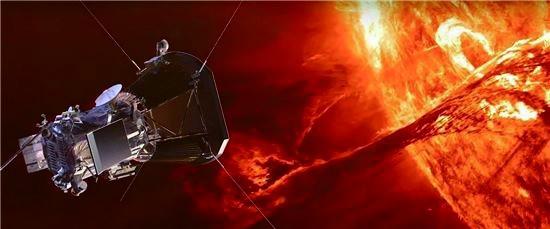【Global Times Comprehensive Report】Nasa's "Parker" solar probe became the first human spacecraft to "touch the sun" three years after its launch. According to CNN reported on the 15th, 60 years after NASA set this goal, the "Parker" solar probe successfully flew over the sun's corona - also the outermost atmosphere of the sun, and analyzed and measured the solar wind particles and the magnetic field of the star.

Thomas Zulbhen, nasa's head of science programs, said in a statement that the Parker probe "touching the sun" was a "truly remarkable feat." "This milestone event not only gives us a deeper understanding of the evolution of the Sun and the impact of this star on the Solar System, but it also gives us more insight into the rest of the universe."
Launched in 2018, the Parker probe is named after astrophysicist Eugene Parker because scientists, including him, hope the solar probe will answer a series of fundamental questions about the solar wind.
Nasa's official website said that unlike Earth, the sun does not have a solid surface, but there is a very hot atmosphere. Relying on strong gravity and magnetic fields, the hot gases that make up the sun are condensed together. But rising heat and pressure push this material away from the sun. The region of the Sun's surface where gravity and magnetic force are equivalent to thrust are called the Alfin Pro interface, which marks the end of the Sun's atmosphere and the beginning of the solar wind. So far, the researchers have not determined the exact location of the Alfin Pro interface, and can only roughly estimate that it is about 10-20 solar radii from the sun's surface, equivalent to 4.3-8.6 million miles.
In April, the Parker probe's research team realized that the probe had entered the solar atmosphere for the first time. During its 8th close-range flight over the Sun, the probe recorded all the special magnetic fields and particles in the boundary region at the end of the Sun's atmosphere and the beginning of the solar wind. It is about 8.1 million miles from the sun's surface. During this close-range flyby in April, Parker was in and out of the corona several times, and the data obtained helped researchers better understand the Alfien Pro interface.
According to reports, the atmospheric structure of the sun can be divided into photospheres, chromospheres and corona from the inside to the outside. Very specially, the temperature of the corona is much higher than the surface of this star, with the hottest temperature detected being about 1 million degrees Celsius, compared to about 6,000 degrees Celsius on the surface of the Sun. The mystery of this, the "Parker" probe may hope to find out.
It will also make 21 "close encounters" to the sun over 7 years before the Parker probe's mission ends. The most critical of these is in 2024, when it will reach a distance of about 3.9 million miles from the sun's surface. To "touch" the sun up close, the Parker probe is well prepared to have a 4.5-inch-thick carbon-based composite shield that can withstand temperatures close to 1371 degrees Celsius while keeping the spacecraft and internal research equipment running in the normal temperature range. (Zhang Jie)